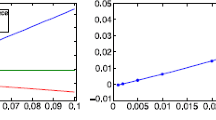Abstract
This article studies an agent's valuation of the right to trade in a complete contingent claims market. The proposed measure generalizes the Pratt (1964) risk premium, which captures the willingness to pay to replace a given risky wealth prospect with an actuarially equivalent, nonrisky wealth. Specifically, we define ageneralized risk premium to be the willingness to pay to trade at going market prices. If state prices are actuarially fair, the Pratt premium is obtained as a special case. We derive several properties of this generalized premium and note its relationship to the option price of a public project under uncertainty.
Similar content being viewed by others
References
Allen, Franklin and Douglas Gale. (1990). “Incomplete Markets and Incentives to Set Up an Obvious Exchange,”The Geneva Papers on Risk and Insuarnce Theory 15, 17–46.
Chew, Soo Hong, Edi Karn, and Zvi Safra. (1987). “Risk Aversion in the Theory of Expected Utility with Rank Dependent Probabilities,”Journal of Economic Theory 42, 370–381.
Choi, E. K. and S. R. Johnson. (1987). Consumer's Surplus and Price Uncertainty,”International Economic Review 28, 407–411.
Colby, Bonnie G. and Dennis C. Cory. (1989). “Valuing amenity resources under uncertainty: Does the existence of fair contingent claims markets matter?”Journal of Environmental Economics and Management 16, 149–155.
Demers, Michel. (1983). “Mean-Preserving Increases in Risk for State-Dependent Utility Functions,” mimeo, Carleton University.
Diamond, Peter and Joseph E. Stiglitz. (1974). “Increases in Risk and Risk Aversion,”Journal of Economic Theory 8, 337–360.
Graham, Daniel A. (1981). “Cost-Benefit Analysis under Uncertainty,”American Economic Review 71, 715–725.
Graham, Daniel A. (1992). “Public Expenditure Under Uncertainty: The Net Benefit Criteria,”American Economic Review, 82, 822–846.
Helms, L. Jay. (1985). “Expected Consumer's Surplus and the Welfare Effects of Price Stabilization,”International Economic Review 26, 603–617.
Karn, Edi. (1985).Decision Making under Uncertainty: The Case of State-Dependent Preferences. Cambridge: Cambridge University Press.
Kocherlakota, Narayana. (1986). “A State-Preference Approach to Risk,” working paper, University of Chicago.
Kihlstrom, Richard, David Romer, and Steve Williams (1981), “Risk Aversion with Random Initial Wealth,”Econometrica 49, 911–920.
Mishan, E. J. (1976). “Choices Involving Risk: Simple Steps Towards an Ordinal Analysis,”Economic Journal 86, 759–777.
Pratt, John W. (1964). Risk Aversion in the Small and in the Large,”Econometrica 32, 122–136.
Pratt, John W. (1990). “The Logic of Partial Risk Aversion: Paradox Lost,”Journal of Risk and Uncertainty 3, 105–113.
Ross, Stephen. (1981). “Some Stronger Measures of Risk Aversion in the Small and in the Large with Applications,”Econometrica 49, 621–638.
Rothschild, Michael and Joseph E. Stiglitz. (1970). “Increasing Risk: I. A Definition,”Journal of Economic Theory 2, 225–243.
Samuelson, Paul. (1972). “The Consumer Does Benefit from Feasible Price Stability,”Quarterly Journal of Economics 86, 476–493.
Schmalensee, Richard. (1972). “Option Demand and Consumer Surplus: Valuing Price Changes Under Uncertainty,”American Economic Review 62, 813–824.
Scotchmer, Suzanne. (1989). “Equivalent Variation with Uncertain Prices,”Economics Letters 29, 127–128.
Segal, Uzi and Avia Spivak. (1990). “First Order versus Second Order Risk Aversion,”Journal of Economic Theory 51, 111–125.
Smith, V. Kerry. (1990). “Valuing Amenity Resources under Uncertainty: A Skeptical View of Recent Resolutions,”Journal of Environmental Economics and Management 19, 193–202.
Smith, V. Kerry and William H. Desvousges. (1988). “The Valuation of Environmental Risks and Hazardous Wastes Policy,”Land Economics 64, 11–219.
Waugh, F. (1944), “Does the Consumer Benefit from Feasible Price Stability?”Quarterly Journal of Economics 58, 602–614.
Yaari, Menehim. (1969), “Some Remarks on Measures of Risk Aversion and on Their Uses,”Journal of Economic Theory 1, 315–329.
Author information
Authors and Affiliations
Additional information
The authors are indebted to an anonymous referee of this journal for helpful comments. We would also like to thank Robert Brooks, Guenter Franke, John Hey, David Mandy, V. Kerry Smith, Paul Thistle, and participants in the Finance Workshop at Tel-Aviv University for their comments on earlier drafts of this article.
Rights and permissions
About this article
Cite this article
Schlee, E.E., Schlesinger, H. The valuation of contingent claims markets. J Risk Uncertainty 6, 19–31 (1993). https://doi.org/10.1007/BF01065348
Issue Date:
DOI: https://doi.org/10.1007/BF01065348



